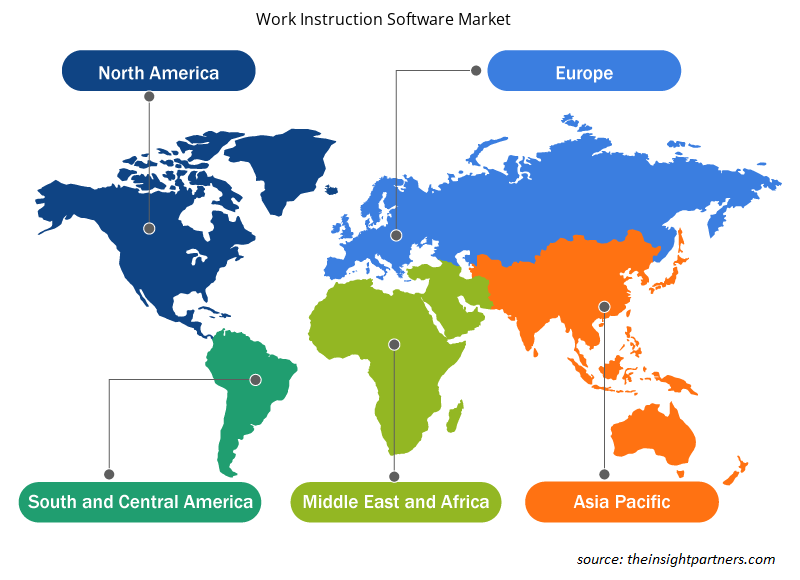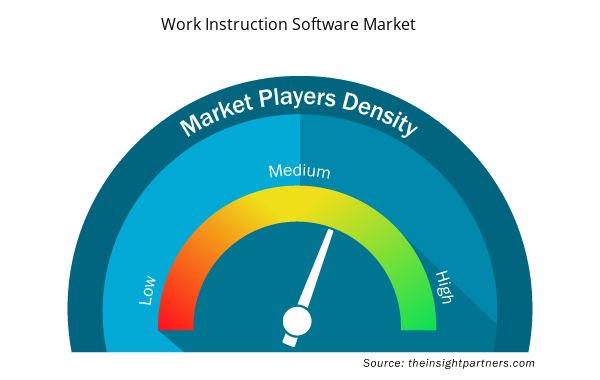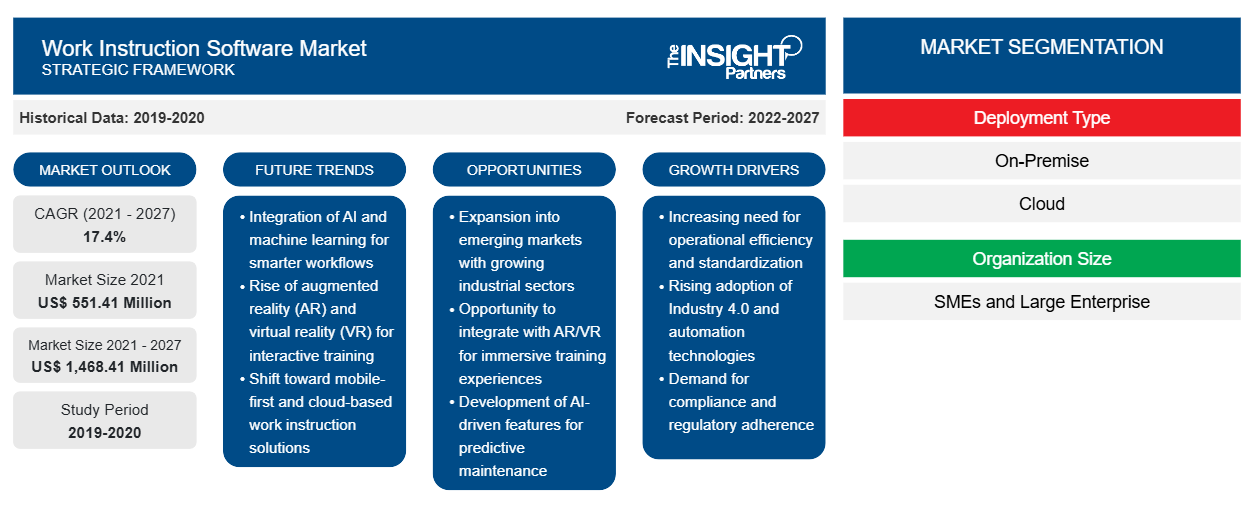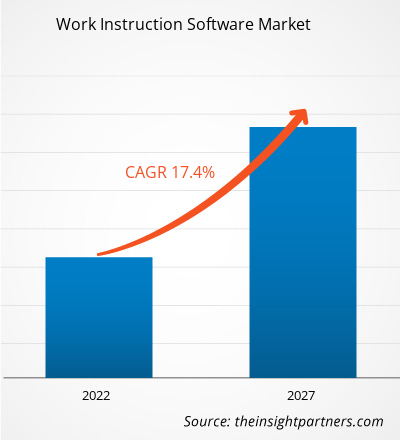Le marché des logiciels d'instructions de travail devrait passer de 551,41 millions USD en 2021 à 1 468,41 millions USD d'ici 2027. Le marché des logiciels d'instructions de travail devrait croître à un TCAC de 17,4 % au cours de la période de prévision de 2020 à 2027.
Le facteur clé qui anime le marché est l'évolution constante des complexités commerciales et de production. L'adoption d'un processus de production à modèle mixte pour améliorer la productivité globale de l'organisation crée le besoin d'une formation et d'un développement améliorés parmi les employés. Cela alimente ainsi l'adoption de logiciels d'instructions de travail dans l'ensemble du secteur manufacturier. Le besoin de formation des employés pour améliorer la productivité conduit à l'adoption de solutions technologiquement avancées dans les entreprises. La complexité accrue des processus de travail dans des secteurs tels que la fabrication, l'automobile, la santé et la vente au détail augmente la demande d'instructions de travail parmi les employés et les ouvriers pour effectuer leurs tâches de manière indépendante et efficace. Par exemple, Augmentir, Inc. propose une plateforme de main-d'œuvre connectée alimentée par l'intelligence artificielle pour aider les employés avec les flux de travail numériques et les conseils à distance tout au long du processus de travail.
Avec la pandémie de COVID-19 qui se propage à travers le monde, il devient évident que peu de personnes peuvent échapper à son ampleur, ce qui présente des défis importants pour toutes les industries. Cependant, l'application principale du logiciel se situe dans le secteur manufacturier, où il est également utilisé pour dispenser une formation aux employés sur le fonctionnement de certaines machines. Ainsi, la fermeture de toutes les unités de fabrication dans les pays développés et en développement devrait avoir un impact négatif sur la croissance du marché des logiciels d'instructions de travail .
En fonction du type de déploiement, les logiciels d'instructions de travail sont segmentés en sur site et en cloud. Les solutions basées sur le cloud devraient connaître le TCAC le plus élevé au cours de la période de prévision. En outre, le marché des logiciels d'instructions de travail en fonction de la taille de l'organisation est segmenté en PME et grandes entreprises. Les grandes entreprises représentaient la part la plus importante du marché. Le marché mondial des logiciels d'instructions de travail a été segmenté en cinq grandes régions : Amérique du Nord, Europe, APAC, MEA et SAM.
Personnalisez ce rapport en fonction de vos besoins
Vous bénéficierez d'une personnalisation gratuite de n'importe quel rapport, y compris de certaines parties de ce rapport, d'une analyse au niveau des pays, d'un pack de données Excel, ainsi que d'offres et de remises exceptionnelles pour les start-ups et les universités.
- Obtenez les principales tendances clés du marché de ce rapport.Cet échantillon GRATUIT comprendra une analyse de données, allant des tendances du marché aux estimations et prévisions.
Informations sur le marché des logiciels d'instructions de travail
Changer la culture du travail au sein de l'organisation
La tendance croissante du BYOD (Bring Your Own Device) associée à la culture du travail à distance dans les organisations, en particulier dans les grandes entreprises, crée le besoin de solutions d'instructions de travail pour assurer le bon fonctionnement de l'organisation. La culture du travail flexible dans les organisations a conduit à l'absence des employés dans les locaux du bureau, ce qui perturbe le flux de travail, en particulier pour les employés de niveau junior qui ont besoin d'une assistance continue pour apprendre et exécuter des tâches en vue d'atteindre des objectifs. L'intégration de solutions d'instructions de travail dans les organisations permet ainsi aux employeurs de former tous les employés sans laisser la barrière physique affecter l'efficacité de la production.
Informations sur le marché basées sur le type de déploiement
En fonction du type de déploiement, le marché mondial des logiciels d'instructions de travail est segmenté en déploiement basé sur le cloud et sur site. Les logiciels d'instructions de travail basés sur le cloud connaissent une forte demande par rapport aux logiciels d'instructions de travail sur site. Le segment du cloud génère la majorité de la demande car il est comparativement moins cher et en raison de la solide infrastructure réseau des pays développés. En outre, les fournisseurs de logiciels d'instructions de travail basés sur le cloud se concentrent fortement sur le développement d'un correctif de sécurité de haut niveau afin d'éliminer le risque de cyberattaque. Ce facteur crée également une demande importante de la part des utilisateurs finaux, stimulant ainsi le marché des logiciels d'instructions de travail.
Informations sur le marché en fonction de la taille de l'organisation
En fonction de la taille de l'organisation, le marché des logiciels d'instructions de travail est segmenté en PME et en grandes entreprises. L'investissement croissant dans les infrastructures de fabrication dans les pays développés et en développement stimule considérablement la demande de logiciels d'instructions de travail parmi les PME.
Les acteurs opérant sur le marché des logiciels d'instructions de travail se concentrent sur des stratégies, telles que des initiatives de marché, des acquisitions et des lancements de produits, pour maintenir leurs positions sur le marché des logiciels d'instructions de travail. Quelques développements des principaux acteurs du marché des logiciels d'instructions de travail sont les suivants :
En avril 2020, SwipeGuide s'est associé à XMReality pour déployer des instructions de travail numériques à l'aide d'un support à distance.
En octobre 2019, Georg Fischer Signet a mis en œuvre AssemblyX de Lifecycle Technology Ltd pour l'instrumentation de travail.
Aperçu régional du marché des logiciels d'instructions de travail
Les tendances et facteurs régionaux influençant le marché des logiciels d’instructions de travail tout au long de la période de prévision ont été expliqués en détail par les analystes d’Insight Partners. Cette section traite également des segments et de la géographie du marché des logiciels d’instructions de travail en Amérique du Nord, en Europe, en Asie-Pacifique, au Moyen-Orient et en Afrique, ainsi qu’en Amérique du Sud et en Amérique centrale.

- Obtenez les données régionales spécifiques au marché des logiciels d'instruction professionnelle
Portée du rapport sur le marché des logiciels d'instructions de travail
| Attribut de rapport | Détails |
|---|---|
| Taille du marché en 2021 | 551,41 millions de dollars américains |
| Taille du marché d'ici 2027 | 1 468,41 millions de dollars américains |
| Taux de croissance annuel moyen mondial (2021-2027) | 17,4% |
| Données historiques | 2019-2020 |
| Période de prévision | 2022-2027 |
| Segments couverts | Par type de déploiement
|
| Régions et pays couverts | Amérique du Nord
|
| Leaders du marché et profils d'entreprises clés |
|
Densité des acteurs du marché des logiciels d'instructions de travail : comprendre son impact sur la dynamique des entreprises
Le marché des logiciels d'instructions de travail connaît une croissance rapide, tirée par la demande croissante des utilisateurs finaux en raison de facteurs tels que l'évolution des préférences des consommateurs, les avancées technologiques et une plus grande sensibilisation aux avantages du produit. À mesure que la demande augmente, les entreprises élargissent leurs offres, innovent pour répondre aux besoins des consommateurs et capitalisent sur les tendances émergentes, ce qui alimente davantage la croissance du marché.
La densité des acteurs du marché fait référence à la répartition des entreprises ou des sociétés opérant sur un marché ou un secteur particulier. Elle indique le nombre de concurrents (acteurs du marché) présents sur un marché donné par rapport à sa taille ou à sa valeur marchande totale.
Les principales entreprises opérant sur le marché des logiciels d'instructions de travail sont :
- Technologie du cycle de vie Ltée
- Gestion des connaissances Livepro
- Guide de balayage
- ScreenSteps, LLC
- Partage de connaissances visuelles Ltée.
Avis de non-responsabilité : les sociétés répertoriées ci-dessus ne sont pas classées dans un ordre particulier.

- Obtenez un aperçu des principaux acteurs du marché des logiciels d'instructions de travail
Marché des logiciels d'instructions de travail – Par type de déploiement
- Nuage
- Sur site
Marché des logiciels d'instructions de travail – par taille d'organisation
- Grandes entreprises
- PME
Marché des logiciels d'instructions de travail – par géographie
- Amérique du Nord
- NOUS
- Canada
- Mexique
- Europe
- France
- Allemagne
- Russie
- ROYAUME-UNI
- Italie
- Reste de l'Europe
- Asie-Pacifique (APAC)
- Chine
- Inde
- Japon
- Australie
- Corée du Sud
- Reste de l'APAC
- AEM
- Arabie Saoudite
- Émirats arabes unis
- Afrique du Sud
- Reste de la MEA
- SAM
- Brésil
- Argentine
- Reste de SAM
Logiciels d'instructions de travail – Profils d'entreprises
- Dozuki
- Systèmes eFlex
- Hexagone AB
- Technologie du cycle de vie Ltée
- Gestion des connaissances Livepro
- Logiciel Optel
- ScreenSteps, LLC
- Guide de balayage
- Partage de connaissances visuelles Ltée.
- Zaptique
- Analyse historique (2 ans), année de base, prévision (7 ans) avec TCAC
- Analyse PEST et SWO
- Taille du marché Valeur / Volume - Mondial, Régional, Pays
- Industrie et paysage concurrentiel
- Ensemble de données Excel



Report Coverage
Revenue forecast, Company Analysis, Industry landscape, Growth factors, and Trends

Segment Covered
This text is related
to segments covered.

Regional Scope
North America, Europe, Asia Pacific, Middle East & Africa, South & Central America

Country Scope
This text is related
to country scope.
Questions fréquemment posées
Based on enterprise size, the work instructions software market is segmented into SMEs and large enterprises. In 2019, large enterprises segment led the work instructions software market. The benefits conferred by work instruction software such as simplifying complex operation processes and real-time visibility are attracting large enterprises to adopt the work instruction software. In any organization, the manufacturing processes is considered as a core component. With the expansion of large enterprises, the manufacturing process and operation of machineries become complex. Work instruction software helps to address all concerns related to regulations, process, and machinery handling, but it is also vital to ensure that the solution selected comprise the right functionality. The market for work instruction software for large enterprises is well-established and is expected to dominate the market during the forecast period.
In terms of revenue share, North America held the largest share of global work instructions software market in 2019 and it is anticipated to continue its dominance over the forecast period of 2020 to 2027. Europe is the second largest revenue contributor, followed by APAC in 2019. The presence of developed countries such as US and Canada coupled with strong industry base is the major factors responsible for high adoption of work instructions software in the North America region.
Further, rise in investments by North American countries, such as the US and Canada, in improving and innovating business processes to offer premium quality products is increasing the need for providing continuous training or real-time assistance to their employees in order to ensure error-free process execution. This is increasing the demand for work instruction software across the region.
Rising demand for training programs across manufacturing industry coupled with the changing work culture across organization are some of the key driving factors for global work instructions software market. Furthermore, constantly changing business and production complexities, and integration of technologies such as augmented reality and artificial intelligence in work instruction software will provide ample growth opportunities to market players operating in the global work instructions software market.
Trends and growth analysis reports related to Technology, Media and Telecommunications : READ MORE..
The List of Companies - Work instructions software market
- Lifecycle Technology Ltd
- Livepro Knowledge Management
- SwipeGuide
- ScreenSteps, LLC
- Visual Knowledge Share Ltd.
- Zaptic
- Hexagon AB
- Dozuki
- eFlex Systems
- Optel Software
The Insight Partners performs research in 4 major stages: Data Collection & Secondary Research, Primary Research, Data Analysis and Data Triangulation & Final Review.
- Data Collection and Secondary Research:
As a market research and consulting firm operating from a decade, we have published and advised several client across the globe. First step for any study will start with an assessment of currently available data and insights from existing reports. Further, historical and current market information is collected from Investor Presentations, Annual Reports, SEC Filings, etc., and other information related to company’s performance and market positioning are gathered from Paid Databases (Factiva, Hoovers, and Reuters) and various other publications available in public domain.
Several associations trade associates, technical forums, institutes, societies and organization are accessed to gain technical as well as market related insights through their publications such as research papers, blogs and press releases related to the studies are referred to get cues about the market. Further, white papers, journals, magazines, and other news articles published in last 3 years are scrutinized and analyzed to understand the current market trends.
- Primary Research:
The primarily interview analysis comprise of data obtained from industry participants interview and answers to survey questions gathered by in-house primary team.
For primary research, interviews are conducted with industry experts/CEOs/Marketing Managers/VPs/Subject Matter Experts from both demand and supply side to get a 360-degree view of the market. The primary team conducts several interviews based on the complexity of the markets to understand the various market trends and dynamics which makes research more credible and precise.
A typical research interview fulfils the following functions:
- Provides first-hand information on the market size, market trends, growth trends, competitive landscape, and outlook
- Validates and strengthens in-house secondary research findings
- Develops the analysis team’s expertise and market understanding
Primary research involves email interactions and telephone interviews for each market, category, segment, and sub-segment across geographies. The participants who typically take part in such a process include, but are not limited to:
- Industry participants: VPs, business development managers, market intelligence managers and national sales managers
- Outside experts: Valuation experts, research analysts and key opinion leaders specializing in the electronics and semiconductor industry.
Below is the breakup of our primary respondents by company, designation, and region:

Once we receive the confirmation from primary research sources or primary respondents, we finalize the base year market estimation and forecast the data as per the macroeconomic and microeconomic factors assessed during data collection.
- Data Analysis:
Once data is validated through both secondary as well as primary respondents, we finalize the market estimations by hypothesis formulation and factor analysis at regional and country level.
- Macro-Economic Factor Analysis:
We analyse macroeconomic indicators such the gross domestic product (GDP), increase in the demand for goods and services across industries, technological advancement, regional economic growth, governmental policies, the influence of COVID-19, PEST analysis, and other aspects. This analysis aids in setting benchmarks for various nations/regions and approximating market splits. Additionally, the general trend of the aforementioned components aid in determining the market's development possibilities.
- Country Level Data:
Various factors that are especially aligned to the country are taken into account to determine the market size for a certain area and country, including the presence of vendors, such as headquarters and offices, the country's GDP, demand patterns, and industry growth. To comprehend the market dynamics for the nation, a number of growth variables, inhibitors, application areas, and current market trends are researched. The aforementioned elements aid in determining the country's overall market's growth potential.
- Company Profile:
The “Table of Contents” is formulated by listing and analyzing more than 25 - 30 companies operating in the market ecosystem across geographies. However, we profile only 10 companies as a standard practice in our syndicate reports. These 10 companies comprise leading, emerging, and regional players. Nonetheless, our analysis is not restricted to the 10 listed companies, we also analyze other companies present in the market to develop a holistic view and understand the prevailing trends. The “Company Profiles” section in the report covers key facts, business description, products & services, financial information, SWOT analysis, and key developments. The financial information presented is extracted from the annual reports and official documents of the publicly listed companies. Upon collecting the information for the sections of respective companies, we verify them via various primary sources and then compile the data in respective company profiles. The company level information helps us in deriving the base number as well as in forecasting the market size.
- Developing Base Number:
Aggregation of sales statistics (2020-2022) and macro-economic factor, and other secondary and primary research insights are utilized to arrive at base number and related market shares for 2022. The data gaps are identified in this step and relevant market data is analyzed, collected from paid primary interviews or databases. On finalizing the base year market size, forecasts are developed on the basis of macro-economic, industry and market growth factors and company level analysis.
- Data Triangulation and Final Review:
The market findings and base year market size calculations are validated from supply as well as demand side. Demand side validations are based on macro-economic factor analysis and benchmarks for respective regions and countries. In case of supply side validations, revenues of major companies are estimated (in case not available) based on industry benchmark, approximate number of employees, product portfolio, and primary interviews revenues are gathered. Further revenue from target product/service segment is assessed to avoid overshooting of market statistics. In case of heavy deviations between supply and demand side values, all thes steps are repeated to achieve synchronization.
We follow an iterative model, wherein we share our research findings with Subject Matter Experts (SME’s) and Key Opinion Leaders (KOLs) until consensus view of the market is not formulated – this model negates any drastic deviation in the opinions of experts. Only validated and universally acceptable research findings are quoted in our reports.
We have important check points that we use to validate our research findings – which we call – data triangulation, where we validate the information, we generate from secondary sources with primary interviews and then we re-validate with our internal data bases and Subject matter experts. This comprehensive model enables us to deliver high quality, reliable data in shortest possible time.


 Obtenez un échantillon gratuit pour ce rapport
Obtenez un échantillon gratuit pour ce rapport